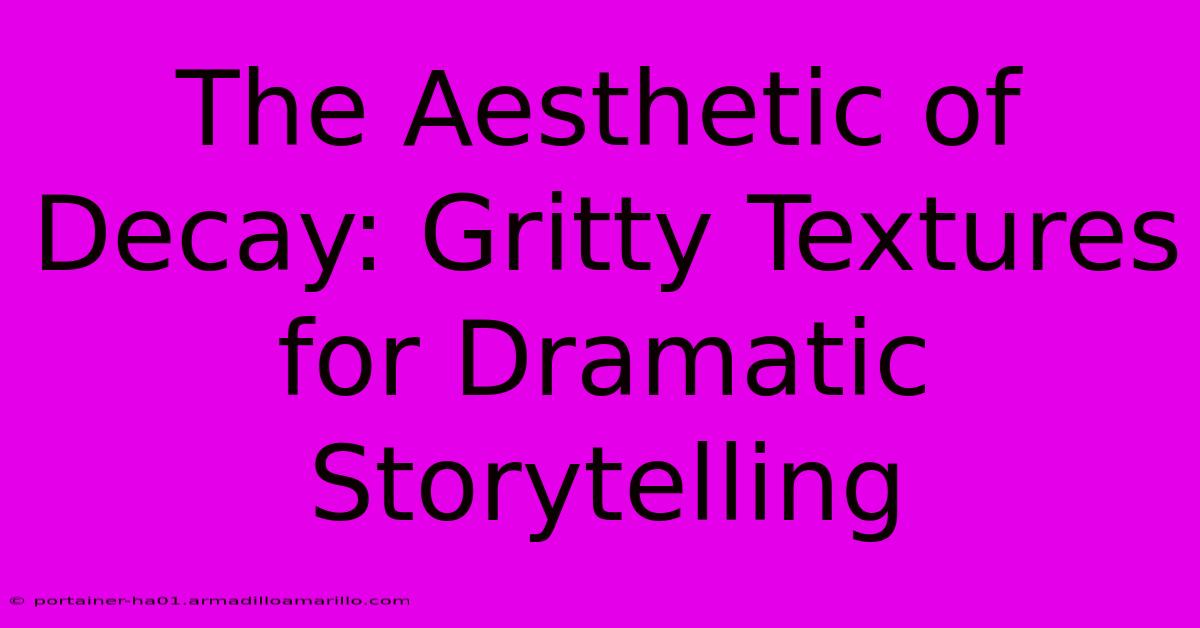The Aesthetic Of Decay: Gritty Textures For Dramatic Storytelling

Table of Contents
The Aesthetic of Decay: Gritty Textures for Dramatic Storytelling
The world isn't always pristine and polished. Sometimes, the most compelling stories are found in the cracks, the rust, the crumbling edges of what once was. This is the power of the aesthetic of decay – a gritty, textured approach that elevates dramatic storytelling to a visceral level. This article explores how to harness the beauty of decay to create captivating narratives across various mediums.
Understanding the Allure of Decay
The appeal of decay isn't simply about showing something broken; it's about revealing a deeper narrative. A crumbling building speaks of history, of forgotten stories, of resilience against time's relentless march. A rusted metal object hints at past use, struggle, and perhaps, even abandonment. This inherent storytelling potential is what makes the aesthetic of decay so compelling.
Emotional Resonance
Decay evokes powerful emotions. It can inspire feelings of nostalgia, melancholy, even a sense of unease or mystery. This emotional resonance is crucial for engaging the audience and drawing them into the narrative. Imagine a scene set in a derelict mansion – the peeling paint, the shattered windows, the overgrown garden – these details aren't just visual; they contribute to the overall atmosphere, influencing the viewer's emotional response.
Visual Storytelling
The beauty of decay lies in its visual richness. The textures are unparalleled: the rough, uneven surfaces, the mottled colors, the intricate patterns of erosion. These visual details add layers of depth and complexity to the story, contributing to its overall impact. Think about the cinematic use of decay in films like "Blade Runner 2049" or "Mad Max: Fury Road." The post-apocalyptic landscapes are not just backdrops; they're integral elements of the narrative, reflecting the societal breakdown and the characters' struggles.
Incorporating Gritty Textures in Your Storytelling
Whether you're a writer, filmmaker, photographer, or game designer, incorporating the aesthetic of decay requires a mindful approach:
Color Palette
Decay isn't just about browns and grays. While these colors are certainly prevalent, consider incorporating muted blues, greens, and even vibrant rust oranges to add visual interest and depth to your palette. The contrast between vibrant decay and a dull background can be particularly effective.
Texture and Detail
Pay close attention to texture. Don't just describe a "worn-out building"; describe the peeling paint, the chipped stone, the rust stains creeping across the metal. The more detail you provide, the more immersive the experience for your audience will be.
Lighting and Composition
Lighting plays a crucial role in highlighting the texture and detail of decaying elements. Use shadows to create a sense of mystery and depth. Experiment with different compositions to emphasize the contrast between decay and other elements in your scene. A dramatic, low-light scene can amplify the feeling of decay and mystery.
Symbolism and Metaphor
Decay can be a powerful metaphor for many things – the passage of time, loss, decline, but also resilience and rebirth. Use decay symbolically to enhance your storytelling and add layers of meaning to your narrative. A decaying garden could symbolize lost love, a crumbling empire could represent the fragility of power, a broken clock could represent the irreversible passage of time.
Examples Across Mediums
The aesthetic of decay finds application across various mediums:
- Film and Television: Post-apocalyptic settings, historical dramas, gothic horror
- Photography: Urban exploration, landscape photography, still life
- Video Games: Survival horror, RPGs with a focus on world-building
- Literature: Gothic novels, dystopian fiction, historical fiction
By thoughtfully incorporating the aesthetic of decay, you can create narratives that resonate deeply with your audience, leaving a lasting impression. It's about harnessing the power of visual storytelling and emotional resonance to create truly captivating work. So embrace the grit, the texture, the beauty of decay, and unlock its storytelling potential.

Thank you for visiting our website wich cover about The Aesthetic Of Decay: Gritty Textures For Dramatic Storytelling. We hope the information provided has been useful to you. Feel free to contact us if you have any questions or need further assistance. See you next time and dont miss to bookmark.
Featured Posts
-
Technicolor Treat The Boldest And Brightest Retro Kitchen Appliances
Feb 07, 2025
-
Print With Precision Our Ultimate Guide To Rolls 90640 Label Printing
Feb 07, 2025
-
Email With A Twist 9 Sign Offs That Will Make Them Smile
Feb 07, 2025
-
The Future Of Communication Mail Hosting Trends To Watch In 2024
Feb 07, 2025
-
Broke Photographers Secret Affordable Dslr That Can Rival The Pros
Feb 07, 2025
